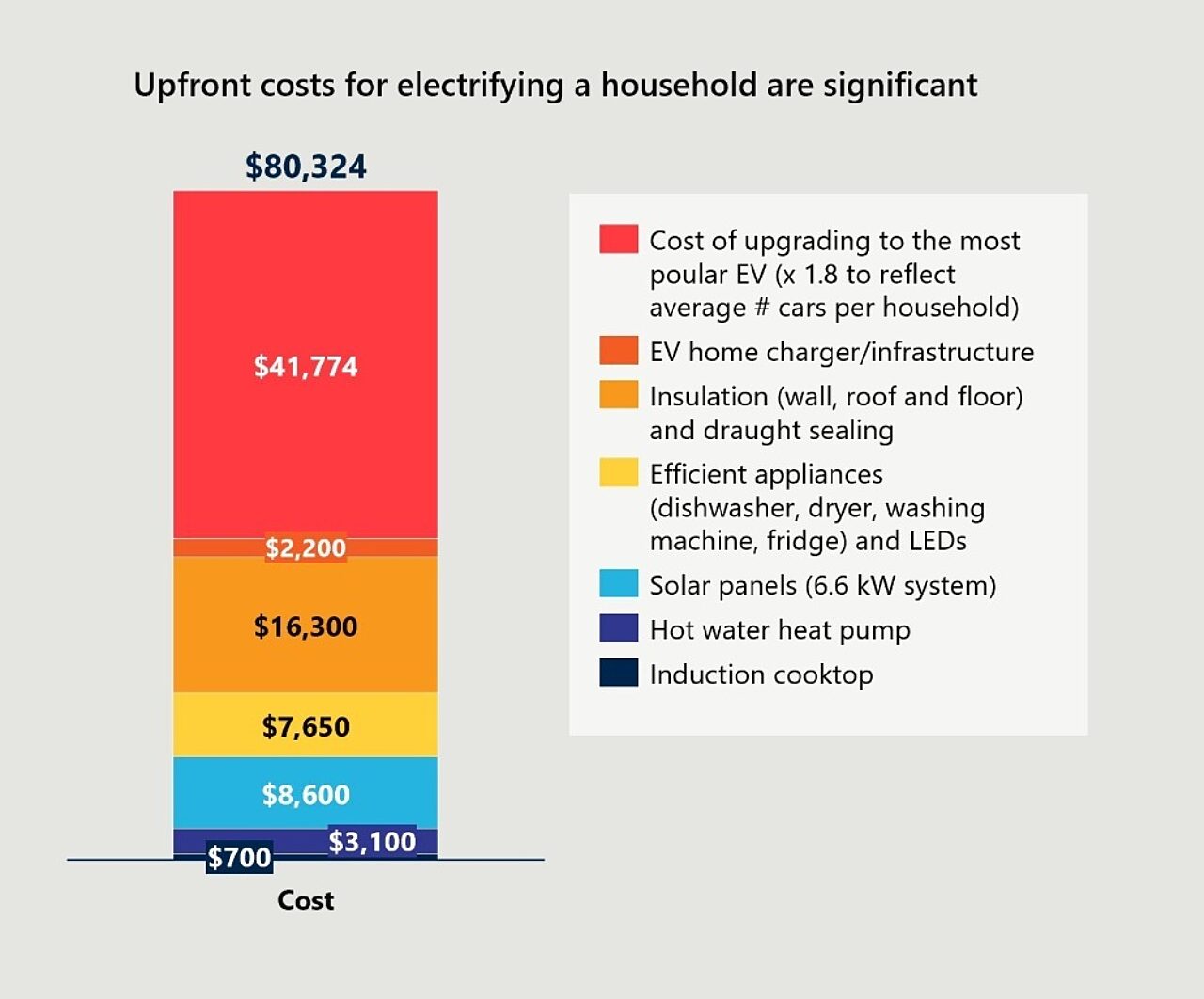Idea In Brief
Electrification
Getting to net zero will impact many aspects of the way we live. It will require full electrification, including installing electric cooktops, hot water, heat pumps and space heating.
Several approaches
There are several ways decarbonisation of households can be accelerated, including through greater clarity about the impact, integrated standards, and a household-centred approach.
Many questions
There are big questions for transition leaders, including how codes and standards should evolve, what regulations and incentives are required, and what supports are needed for households.
Welcome to Pathways to Net Zero
“Everyone is entitled to their own opinion, but not their own facts.”
Never has this saying been more relevant than in the discussion about climate change and the way to achieve net zero emissions.
The public square is filled with people making claims about an array of technologies that can get Australia to net zero, but the integrity of the claims and the robustness of the evidence can be hard to judge.
That was why we were part of Net Zero Australia, a multi-year analysis of how Australia can achieve net zero emissions for both our domestic and export economies. This analysis, the first of its kind in Australia, offers a rigorous, objective, granular and transparent analysis of pathways to net zero.
The reports from Net Zero Australia – a partnership of Nous Group, the University of Melbourne, the University of Queensland and Princeton University – deliver practical insights for businesses, governments, and communities for the decades ahead.
But how can you act on what we have learned?
In this insights series, Pathways to Net Zero, our expert team will highlight the key findings from Net Zero Australia and what they mean for your organisation. We will offer a factual explanation of the issues and identify the key questions and opportunities for companies and governments.
We hope you find the series illuminating. We welcome the chance to talk with you about how the issues impact your organisation.
Pathways to Net Zero: The challenge of decarbonising households
Households are at the heart of the transition to net zero. While individual decisions have helped lead our transition so far (such as through record rooftop solar rollouts and uptake of electric vehicles), there is much more to do to fully decarbonise our homes. Further investments and changes are required at a time when cost of living pressure is high.
Getting to net zero will impact many aspects of the way we live. It will require full electrification, including installing electric cooktops, hot water, heat pumps and space heating. Renewable generation and storage, including solar, batteries and control technology, will be key. Renewable transport (which will also serve as energy storage in the home) will require electric vehicles with two-way energy flow capability. Supporting technology, including smart metering, smart charging and demand response, will be required to optimise costs and reliability. Old infrastructure must make way – decommissioning gas and abolishing and making safe old connections points.
We know from the Net Zero Australia mobilisation report that there are substantial costs involved:


Source: Net Zero Australia mobilisation report, from CSIRO’s GenCost 2020-21, Drive’s Australia’s best-selling electric cars of 2022, RACV’s Australian new car sales 2022, Australian Government’s Pathways to scale: Retrofitting One Million+ homes, ABS’s Transport: Census (2021)
Of course, each household will be impacted differently. The transition will look different for a group of friends sharing an inner-city townhouse compared to a family paying off a mortgage on a house, or a retired couple living on their farm.
To succeed, change needs to be as low impact as possible and tailored to ensure broad and ongoing support. Get it wrong and we risk being on the wrong side of public opinion (or only gaining support from early adopters), which would significantly slow the transition. Time is not on our side.
What comes next?
We think there are several ways decarbonisation of households can be accelerated:
Households need clarity about how the energy transition will affect them and the support available. In its June 2023 Consumer Sentiment Survey, Energy Consumers Australia found that only one in five households and one in three small businesses believe the impact of the transition to renewable energy has been clearly communicated. The survey also found that 52 per cent of households are more concerned about paying their electricity bill than they were a year ago. There is a significant information gap that needs to be filled.
Integrated standards and a transition plan for the zero-emissions home need to be defined. Households need to know what a zero-emissions home looks like. This means setting standards for efficiency, smart metering, controlled charging, demand response, solar, storage and appliances. Decarbonisation and the design of new builds and retrofits must prepare households for the compounding effects of climate change. So changes to the built environment are needed to improve resilience to increased risk of heat, storm, flood and bushfires.
The pace and scale of electrification and efficiency upgrades need to be more ambitious. So far switching has been fragmented as consumers incrementally adopt solar, batteries and electric appliances rather than adopting a whole-of-home decarbonisation. Completely electrifying a home requires a significant investment (even when subsidised) and is locking out many households. As we go down the path of electrification and efficiency upgrades, we need to be aware of risks, including industry tipping points (such as the closure of gas distribution networks); social impacts arising from higher energy costs disproportionally impacting non-electrified dwellings; and slowed abatement in energy production if demand growth outstrips the growth of decarbonised power.
Acceleration requires a household-centred approach to funding, incentives, standards, education and transition. The biggest challenge to the transition is not technology – it is people. To fund the transition, we must nudge purchasing decisions while ensuring no adverse impacts on vulnerable people. Incentives need to be tailored for household type, capacity to pay, and living arrangements, and consider the range of investments needed to electrify. Policymakers must make hard calls on standards for new homes or refurbishments to ensure the core infrastructure is in place and expensive retrofits are not required later. Customers need education, communication and support to navigate a complex system and understand the benefits of switching.
The big questions for transition leaders
For the federal government:
- How will codes and standards evolve to ensure all new and refurbished homes are decarbonised?
- What is the fairest method of funding the decarbonisation of homes, balancing socialised and user-pay costs?
- What is the best mix of incentives and policy interventions to accelerate households electrifying?
For state governments:
- What regulations and incentives will support the transition for renters or owners’ corporations?
- What measures will accelerate the switch from gas without causing disruption or high investment costs?
- How can governments support innovation and local businesses that will play a key role in the transition?
For local governments:
- What communication, education and support programs can be deployed in local communities to ensure households have information to make informed decisions?
- How can local government more effectively advocate for change to other layers of government on behalf of their constituents?
For energy retailers:
- How will product and service offers reduce complexity and give customers a simple and affordable way to electrify their homes?
- What incentives can retailers offer to accelerate the transition to electric appliances?
- How can retail offers maximise innovation to provide customers a green offer at the lowest cost (such as using virtual power plants, distributed resources and metering data)?
For utilities:
- What investments should utilities make to provide the physical and market platforms that will enable innovative new green products such as consumer energy resources (CER) and smart charging?
For industry:
- How can industry and government partner to accelerate a just transition?
- What market signals would drive genuine, substantial investment in new products, services and businesses to support the transition?
- Are there untapped opportunities for businesses to disrupt the market with low-cost alternative ways of powering homes (such as off-grid solutions and community infrastructure)?
Get in touch to discuss how these issues impact your organisation.
Connect with Phillip Vrettakis, Brenden Carriker and Alasdair McCall on LinkedIn.

